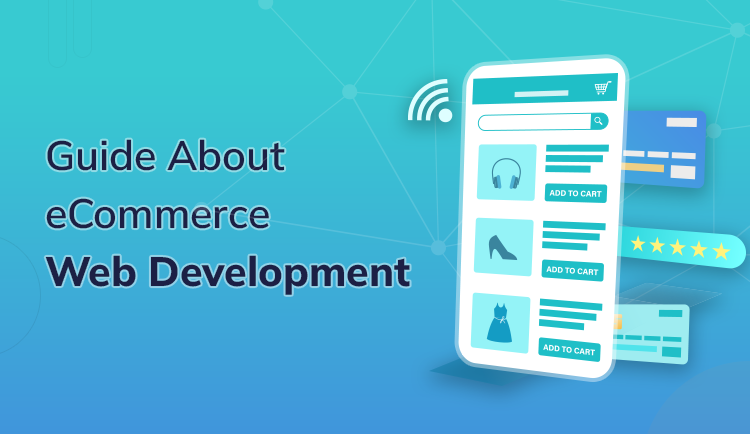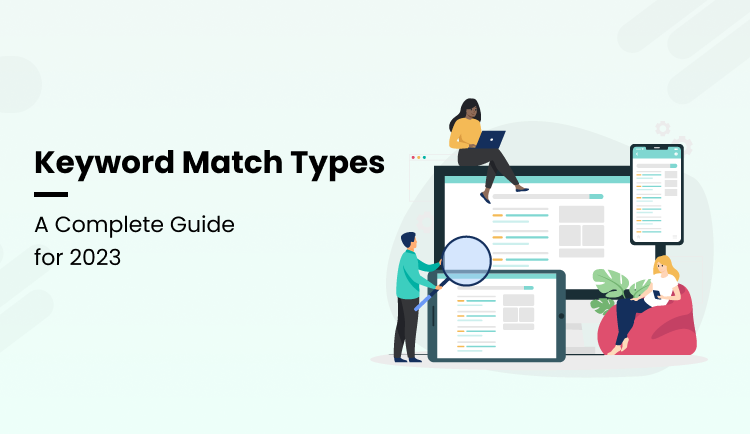
A 2022 Guide About eCommerce Web Development
eCommerce web development is the newest trend today. And do you know why?
Because online shopping is in the mainstream, people from all walks of life prefer to shop online. And why not? After all, it makes the shopping experience a breeze. Without having to move out of the house, one can buy whatever he or she desires. In fact, you can even make a purchase during your office breaks!
The ease of shopping from anywhere gave rise to an increased number of online shoppers worldwide. As the number of shoppers grows, the number of online stores also grows. Research indicates that there are around 26 million eCommerce sites actively operating around the globe.
So, how can one make yourself noticeable?
Yes, 26 million eCommerce sites are no small deal! You need the right strategy to STAND OUT!
And the first and most crucial step to stand out is to have a well-developed eCommerce website. A well-developed eCommerce website is only possible with the right eCommerce web development.
A well-designed eCommerce website is not only visually appealing but also helps you establish brand equity that will propel your firm ahead.
So, if you’re planning to start an online store but are not sure where to start from, read this post.
In this post, we’ll walk you through the process of eCommerce store development to help you take the right first step.
So, let’s get started…
What is eCommerce website development?
Developing an e-commerce site entails carrying out the steps outlined in the build strategy for both the server side and client-facing components of the site. Everything from your shopping cart to product pages, order forms to support pages are a part of eCommerce development.
eCommerce website development gives you the privilege to tailor the features and functionalities of your site to match your business’s model and specific requirements.
It is one of the most crucial steps to succeed in the world of online business. Only a reputable eCommerce website developer or an eCommerce web development company, such as Annexlogics, can help you succeed.
Factors to Consider When Building an Online Store
Here is a list of things you must consider while eCommerce web development:
#1. Determine the Functionality of your Site.
There are myriads of things you need to consider before you opt for eCommerce web development. Before you begin, you need to determine the functionality requirements for your e-commerce website based on your intended outcomes.
There needs to be tight congruence between these and the stages of your customer’s journey.
You will need to figure out what features and functions you need in your shopping cart. An eCommerce website must have functions like order forms, tax and shipping cost calculations, preferred payment methods, and so on.
Having all the MUST HAVE FUNCTIONS on your website will help you streamline your day-to-day operations.
#2. Responsive Site.
Since the majority of online transactions now occur on mobile devices, a mobile-friendly website design is crucial for successful e-commerce.
Customers today expect a seamless shopping and browsing experience, even while they’re on the go with their smartphones.
According to eMarketer’s forecasts, worldwide sales from M-Commerce will reach $4.5 trillion, which is approximately 69.9% of all eCommerce sales.
If you want to compete, you need a mobile-friendly, responsive web design for your retail site.
Consumers expect your website to be easy to navigate, whether they’re using a desktop computer or a mobile device.
Since mobile is the most rapidly expanding channel, customers have high expectations that they will have the same simple, streamlined buying experience on their mobile devices that they do on their computers when they visit your website.
A responsive site design automatically adjusts to the screen size of your computer, tablet, or mobile phone. Responsive web design is essential to help your target customers have a fantastic experience regardless of the device they use.
#3. Search Engine Optimization.
Search engine optimization (SEO) is a must in today’s competitive online environment. Gaining a high Google search engine ranking for targeted keywords helps increase organic search traffic. Search engine optimization is the greatest tool that can help you have increased organic traffic.
Successful businesses use search engine optimization as one of their primary strategies for growing their bottom line.
Understand that the success of an online store depends both on attracting new consumers and keeping the ones they already have. Your store will struggle to expand if you are unable to attract new customers.
Utilizing search engine optimization can help you attract new, highly-qualified customers. Moreover, SEO enables you to win over the trust of online shoppers.
#4. Internet Access Time.
Page speed plays a crucial role when it comes to successful eCommerce web development. A website’s page load time is a quantitative indicator of its overall performance. The better the speed of your page, the better the ranking will be.
Google uses page load time as a ranking element; therefore, websites that load quickly have an advantage in search engine rankings. Therefore, it is important to employ eCommerce website developers that are well-versed in making online stores that are not only visually appealing and user-friendly but also quick to load.
#5. Content Management System.
Another important factor to consider when opting for eCommerce web development is the content management system.
Having a content management system (CMS) is essential for an eCommerce site. It centralizes all of the site’s dynamic material, including blogs, articles, videos, images, etc.
Using a content management system, you may update or add to your eCommerce site’s content with ease, and the changes will be reflected instantly. This allows you to keep your site regularly updated with fresh material and stay ahead of the game at all times.
#6. Site Management
Implementing the right eCommerce web development practices can lead to the expansion of an eCommerce store. And product management is one such practice. Products in internet retailers can’t be strewn about randomly like they often are in real stores.
An online store needs to be well-organized. That’s the reason most online stores, such as Amazon, have different sections category-wise. You must also consider having well-managed product sections on your website.
Using the right product management strategies will allow you to streamline your day-to-day operations. Everything from inventory management to handling customer grievances should be handled properly.
#7. Checkout and Payment Options.
Different people prefer to use different payment modes when purchasing online. Some of your customers would pay on the spot via credit card, or internet banking, or mobile wallets. In contrast, others may prefer to pay cash on delivery.
In this day and age with Amazon Pay, PayPal, Internet Banking, and mobile wallets having only one payment method is a big NO when you want to compete in the online market.
It is vital that your e-commerce platform can interface with a variety of payment methods. Doing so will improve your bottom lines as it will encourage your buyers to spend more.
#8. Cyber Security.
Security is one of the most important aspects of successful eCommerce web development. If your site is not secure for your buyers, they won’t come to you ever, mind it!
When creating an online shop, you must deal with sensitive information such as customer phone numbers, credit card numbers, and other payment details.
Cybercriminals employ cutting-edge methods to steal sensitive data from companies. Therefore, it’s vital to safeguard not only your own information but also that of your customers. You risk having sensitive customer data stolen if your cyber defenses are breached.
Even a small cyber-attack can jeopardize customers’ trust and your brand’s name. Therefore it is crucial to provide your customers with immense security. Doing so will help you develop and win their confidence and have them associated with your brand for a long time.
How to Make a Customized Ecommerce Website
Gone are the days when eCommerce web development was a task. Today, it’s a breeze for all. Whether you’re tech-savvy or not, you can have a stunning eCommerce platform to sell your gorgeous products.
So, what do you need to develop an eCommerce site?
DETERMINATION! That’s all!
Yes, there are a lot of platforms that can help you set up an online store with little or no technical know-how on your part. But figuring out your platform isn’t the only thing you need to do before you can start making your game.
Before you jump in, here are some things to think about.
1. Know the WHY of your Business.
It’s a big step to decide when you opt for eCommerce web development. And you can’t accomplish anything unless you know the WHY of it. Yes, start with why you want to do it. Ask yourself: Why do you want to sell things online?
Once you know your WHY, planning it further will become a breeze. Aside from that, you should also think about eCommerce metrics along with the kind of growth you want to see in the future.
2. Figure out the Model of your eCommerce Business.
Yes, it is crucial to decide when you’re planning eCommerce website development. There are myriads of business models. However, the two that are pretty popular include Business-to-business (B2B) and business-to-consumer (B2C).
Knowing the kind of model you want to opt for is imperative. When we say B2C business model, it simply means to sell directly to the consumers. For example, Amazon.
While in the case of the B2B business model, you sell your products or services to a business. Alibaba is a great example of a business-to-business eCommerce.
3. Know your Target Audience.
Only knowing the business model is not enough. You must know your audience as well.
Who do you want to sell your products to? It is a major question when opting for eCommerce web development. Your site must reflect it.
For example, you choose to start an online store only for oldies. Here oldies will be your target audience. Now everything in your eCommerce website, from its design to enlisted product, must reflect that.
To begin an eCommerce business, you must put in a little bit of work to learn more about your customers.
Everything on your site must be made considering your potential customers, including the user experience and user interface, the visuals of the web design, the content, and more.
Moreover, you should know the age, demography, tastes, and preferences of your potential customers. All of this information will help you create an eCommerce website that is tailored to their tastes and needs. This will help you connect with them better and give your customers a better experience.
4. Buy a Domain Name.
To have your online store, you’ll need a domain name. Now it’s time to register the domain name. You can purchase a domain name from any platform, such as Godaddy, Mailchimp, Hostinger, and so on.
Know that buying a perfect URL is essential. It can either make or break the game for you. So, don’t delay the process.
5. Find out the Right Platform.
Once you have purchased the domain name, it’s time to find a hosting platform. There are many eCommerce solutions to choose from, so you can find the one that works best for you.
Different eCommerce platforms offer different features. That’s why you need to know which features you need to make your online business the best it can be. Some of the very popular eCommerce platforms include Shopify, Magento, BigCommerce, and so on.
Each platform has its own upsides and downsides; you need to choose the one that matches your needs perfectly.
6. Customize your eCommerce Site.
After you have chosen your hosting platform, you can customize your eCommerce site. Your website is more than your brand logo. So make sure to create a visually appealing website.
Use your business’ color theme to make it easily recognizable. Also, remember not to make your website complicated in order to make it jazzy. Customers like simple and easy-to-navigate sites.
Have simple searching and filtering options on your website to help customers have a fantastic user experience.
Lost sales and a damaged brand reputation can be the result of a poorly designed website. If designing an eCommerce website seems like a task, take help from professional eCommerce website developers, such as Annexlogics.
7. Add Items.
Some of the steps in the process will be for one time only. But the adding of items is an ongoing procedure. So make sure adding and modifying product listing is not a challenge for you. Therefore, it is crucial to consider this during eCommerce web development.
The ease of adding and modifying items can make things easier in the back office and streamline your day-to-day operations.
Here are some of the most important pointers to remember when adding items to your website:
- Take high-quality pictures of products on your site. Doing so will help you attract more and more customers.
- Give detailed product descriptions. Yes, adding a detailed description of each and every product on your site is essential. So, don’t miss to include all relevant information, like product specs, sizing information, etc. Customers prefer to buy products that are described well.
- Have a review section. Having a review section for each product is a MUST. More often than not, customers make a purchase decision based on the reviews of past customers.
8. Payment and Shipping.
An eCommerce website developer can help you with your shopping cart and checkout, as well as with setting up payment gateways and shipping. There are a multitude of gateways to choose from. You don’t have to connect them all.
However, having multiple payment modes is essential. Have the ones that are most used by your target audience and the ones that work best in the countries where you want to sell.
9. Launch your Website.
More often than not, entrepreneurs wait until they think it’s perfect to launch their website. You don’t need to follow them. Once you have tested that everything on your site is working well, it’s time to launch your site.
If you’re waiting to achieve perfection, you’ll keep waiting until infinity. Know that perfection is an illusion. Tweaking and split-testing is a continuous process with eCommerce web development – never stop doing that.
Don’t let your doubt or procrastination keep you from starting your online business.
10. Maintain your eCommerce Site.
Only launching your eCommerce website won’t be enough. Maintaining your online store is one of the most crucial steps in eCommerce web development.
Your e-commerce website will need to be updated on a frequent basis. Doing so will accurately reflect any changes to your stock, product line, or special offers that you may come up with.
Closing Thought
With that, we conclude our guide to successful eCommerce web development. Hopefully, you have understood how important it is to create a functional online store.
Make sure to thoroughly analyze your company’s requirements and objectives before you begin. These metrics will influence each decision you make on the way to eCommerce store development.
And if you think managing everything on your own won’t be easy for you, we suggest taking professional help. Annexlogics is a leading company that can help you create a fully-fledged eCommerce website.
We provide a wide range of services, including eCommerce website development. Whether you want to revamp your existing store or are planning to start a new one, contact us. We will help you with all the tools and resources required to build a stunning eCommerce store. With us, you’ll have your online store up and running in no time.
We’re excited to help you in your endeavor; contact us for more details on our services!




